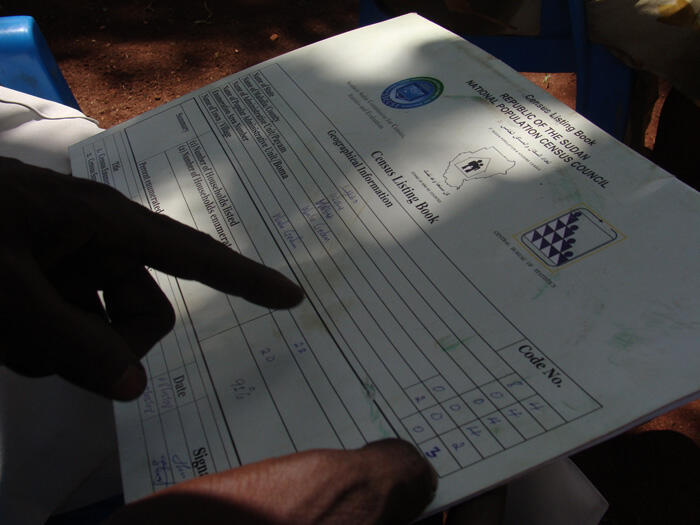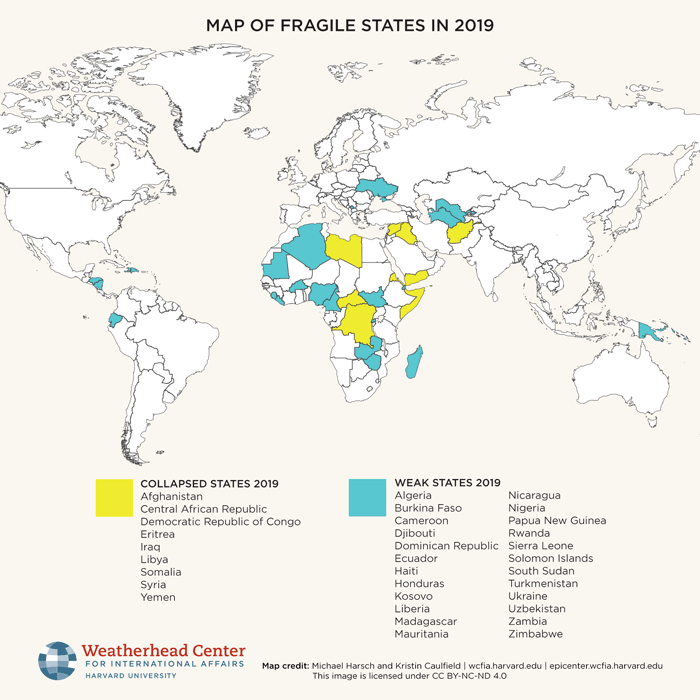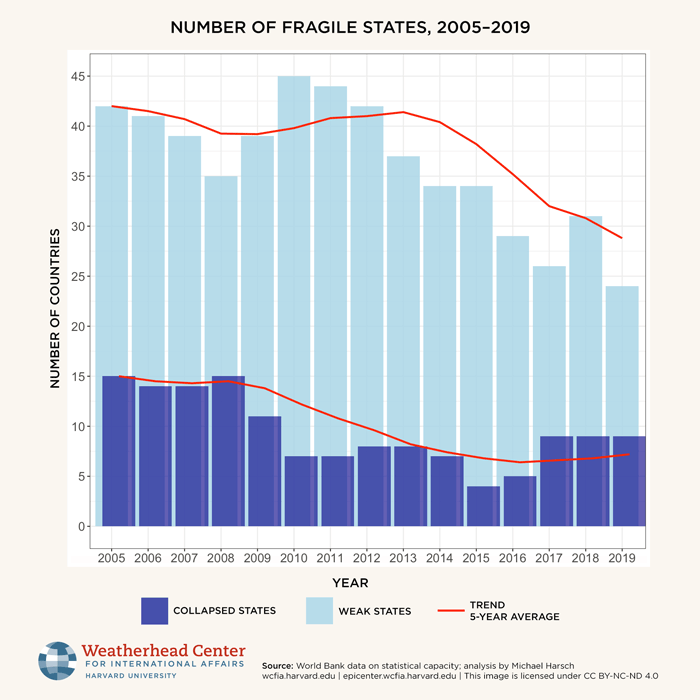When assessing a developing country’s need for aid, an important metric often gets overlooked: the ability of a state to collect statistics on its population, says Visiting Scholar Michael Harsch.

By Michael Harsch
As the world continues to grapple with containing COVID-19 and its fallout, one group of countries remains particularly vulnerable to economic hardship, political instability, and violent conflict: fragile states.
Fragile states are countries whose central governments lack the capacity to administer their territories effectively. Even before the start of the pandemic, these countries deprived their populations of basic socioeconomic opportunities, provided fertile ground for extremist groups, and constituted the “weakest links” in global efforts to eradicate diseases such as polio. Now the United Nations and the IMF warn that the sharp economic downturn could further aggravate food insecurity and political tensions in these countries; scholars predict that more countries will experience instability in the coming two years than at any point over the past thirty years.
In October, the IMF and the World Bank will hold their first virtual annual meeting, which presents an important opportunity to rethink the international approach to stabilizing fragile states.
Despite the grim predictions of increasing instability, there is some surprising good news: according to a new, simple measure of developing countries’ administrative capacity, the number of fragile states has nearly halved over the last one-and-a-half decades. (A worrisome exception are countries with extremely low administrative capacity, or collapsed states, whose number has slightly increased over the past five years.) This new approach to measuring state fragility, which I am developing in the context of a book project on “islands of stability in fragile states,” could help the US and other leading donors to allocate development assistance more effectively and gauge the long-term effects of their engagement.
Problems with current measurements
A key obstacle to developing a more effective policy is the lack of a clear measure of state fragility. Existing rankings and listings of fragile states (for example by the Fund for Peace, the World Bank, and the OECD) measure the consequences rather than the causes of fragility. They combine a surfeit of indicators—the OECD uses forty-four—from conflict incidents to social protection and food security, which are arbitrarily weighted and the underlying data is often not fully disclosed. The resulting aggregate scores are difficult to interpret and compare, both over time and between countries. For example, according to the 2020 edition of the most prominent ranking, the Fragile State Index, Cameroon (11th) is more fragile than both war-torn Libya (20th) and Iraq (17th).
Despite considerable criticism, measures of state fragility continue to inform donor decisions about aid allocation and debt relief. We thus need a sound strategy for identifying these countries and disentangle fragility from concepts such as poverty and conflict.
Legibility: A crucial indicator of state fragility
According to the political scientist and anthropologist James Scott, state capacity is a function of legibility: the government’s ability to collect and standardize basic information about its citizens. Fragile states do not just have less accurate census data, but lack even the most basic population statistics. They are thus “partially blind,” which severely undermines the central government’s ability to control the territory, raise taxes, and plan strategically.
The best indicators of state fragility might be missing indicators. I therefore leverage data on the statistical capacity of countries, which the World Bank began to collect in 2004. These data allow us to assess and compare state fragility across the globe. I classify states as fragile if they lack two or more of the following three crucial types of records: 1) a vital (birth and death) registry that the UN Statistics Division judges to have complete records within the last fifteen years; 2) a population census; and 3) an agricultural census (land use, production, etc.). Each of these censuses is considered as up-to-date for one decade, starting the year after their completion.1
A measure based on legibility significantly improves our understanding of fragile states on multiple fronts.

Two degrees of fragility
According to my measure, in 2019, thirty-three developing countries and territories qualified as fragile.2 We can distinguish between two groups with different degrees of fragility. Twenty-four countries lacked two types of records (agricultural census, population census, or vital registration); we may call this group “weak states.” Nine countries lacked all three types of records; we can refer to this group as “collapsed states.” The latter includes Afghanistan, the Central African Republic, the Democratic Republic of the Congo, Eritrea, Iraq, Libya, Somalia, Syria, and Yemen. South Sudan will join the group of collapsed states in 2020 (since the World Bank will then stop counting Sudan’s controversial 2008 population census for South Sudan). These results are similar to existing listings; yet they are easier to understand and confirm legibility as a powerful indicator of state fragility.
Global trends
The overall trend is remarkably positive: from 2005 to 2019, the number of fragile states has nearly halved, from fifty-seven to thirty-three. The increase in legibility is an encouraging development, which might have contributed to the astonishing global decline in poverty over the past twenty-five years. Yet there is also one deeply troubling trend: the number of collapsed states has remained largely stable over the last decade, with a slight uptick since the all-time low in 2015. Conflict and extreme poverty thus remain concentrated in a small yet significant set of countries across Africa, the Middle East, and central Asia.

National trajectories
A closer look at individual countries paints a nuanced picture. Many countries have made progress in (re)building state capacity; others have stagnated or lost capacity. For example, Angola, emerging from a protracted civil war, lacked basic statistics about its population in 2005. But the Angolan government’s information about its citizens increased following a 2014 population census—the country’s first census since gaining independence from Portugal in 1975; in 2019, after launching an agriculture and fisheries census, Angola left the group of fragile states. By contrast, Afghanistan’s trajectory is sobering: while the United States has spent more money on rebuilding the country than it spent on the entire Marshall Plan to reconstruct Europe after World War II, the government still lacks fundamental statistics. Iraq, finally, did not belong to the group of fragile states prior to 2003. Yet since the US invasion that year, Iraq has been unable to conduct a new population and agricultural censuses, and it was relegated to the weak state category in 2009; by 2018, it qualified as a collapsed state.

Conclusions and policy implications
Legibility complements and improves upon existing measures of state fragility: it is simple, transparent, and universally applicable. It highlights that “states fail not because they have too much bureaucracy, but because they have too little.” International donors should therefore put a greater emphasis on helping fragile countries build effective bureaucracies, which has the potential to increase fiscal capacity and improve a wide range of development outcomes.
One important caveat is that legibility captures longer-term rather than year-to-year changes in state capacity. Yet this seems appropriate given that bureaucratic capacity takes time to build and typically decays slowly. Even in the most extreme cases such as Iraq, where the United States’ ill-conceived policies of de-Baathification and dismantling the Iraqi army severely reduced state capacity, the decline was gradual. Thus, rather than offering a precise estimate of the year when Iraq or Syria became collapsed states, a legibility-based approach is most useful for understanding the three-to-five year trajectories of such countries.
Finally, even in the best-case scenario, most of today’s fragile states will likely remain so for some time. But there is an important additional take-away for the governments of these countries: in order to succeed, they need to demonstrate to their population that it is safe and beneficial for everyone to share information with the authorities. For example, Somaliland or the Kurdistan Region of Iraq effectively compensate for the lack of formal records by engaging in close cooperation with the population in the areas of security and service provision. Other countries and regions could learn from these examples and alleviate their limited legibility.
The World Bank and the IMF could use legibility as a complementary measure to assess three-to-five year trends in state fragility and, thereby, countries’ need for development assistance. Specifically, they could formalize quality standards for censuses and other key statistical records, which encourage accurate, nondiscriminatory data collection and specify criteria for including—or excluding—a statistical record from the World Bank’s dataset. A clearer understanding of fragility thus offers valuable lessons, which could advance state building efforts in critical regions of the world.
—Michael Harsch, Visiting Scholar, Weatherhead Center for International Affairs
Michael Harsch is a Visiting Scholar with the Weatherhead Scholars Program. He is also a visiting assistant professor of international relations at the Frederick S. Pardee School of Global Studies, Boston University. His research focuses on international security, international organizations, conflict and development. He is working on a new book about fragile states.
Captions
- Census Listing Book, Sudan, May 14, 2008. Credit: Erica Frank, Flickr (CC BY-ND 2.0)
- Population and household agent speaks with a resident in Luanda's Malanga neighborhood as they proceed with the census operation on May 16, 2014. This was Angola’s first census since gaining independence from Portugal in 1975. Credit: ESTELLE MAUSSION/AFP via Getty Images
- Map of Fragile States in 2019. Several states that have experienced political instability in recent years, specifically Burundi, Chad, Mali and Sudan, will likely qualify as fragile states by 2020/2021 when their population censuses become outdated. Credit: Kristin Caulfield
- Number of Fragile States, 2005–2019. The trend line shows the five-year moving average (current year and previous four years of data, where applicable). Source: World Bank data on statistical capacity; analysis by Michael Harsch
References
- Some of the World Bank’s coding decisions are debatable, such as including Iraq’s 1997 census which excluded the Kurdish region. And while the dataset now reaches back to 1985, a number of gaps remain prior to 2005. Still, the World Bank’s data is more comprehensive and up-to-date than historical datasets on statistical capacity, and more reliable and readily available than other indicators of state capacity such as tax revenue.
- This figure excludes small states with less than 250,000 inhabitants.
Acknowledgement
I thank Olivia Leone and Yunan Yang for excellent research assistance.
